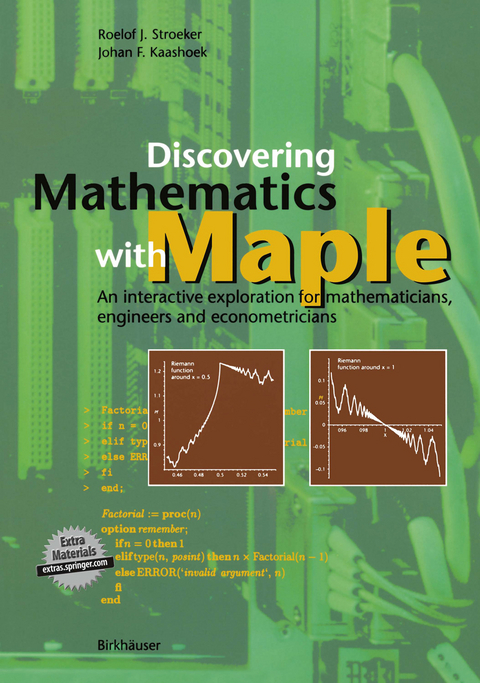
Discovering Mathematics with Maple
Springer Basel
978-3-7643-6091-7 (ISBN)
1 A Tour of Maple V.- 1.1 Introduction.- 1.2 Maple's User Interface.- 1.3 Just a Maple Session.- 1.4 Worksheets and Assignments.- 1.5 Exercises.- 1.6 Survey of Used Maple Expressions.- 2 Functions and Sequences.- 2.1 Introduction.- 2.2 Selected Concepts from Analysis.- 2.3 A Tricky Probability Function.- 2.4 Worksheets and Assignments.- 2.5 Exercises.- 2.6 Survey of Used Maple Expressions.- 3 Matrices and Vectors.- 3.1 Introduction.- 3.2 Selected Concepts from Linear Algebra.- 3.3 A Least Squares Filter.- 3.4 Worksheets and Assignments.- 3.5 Exercises.- 3.6 Survey of Used Maple Expressions.- 4 Counting and Summation.- 4.1 Introduction.- 4.2 Selected Concepts from Discrete Mathematics.- 4.3 Binomial Coefficients.- 4.4 Worksheets and Assignments.- 4.5 Exercises.- 4.6 Survey of Used Maple Expressions.- 5 Derivative and Integral.- 5.1 Introduction.- 5.2 Further Concepts from Analysis.- 5.3 Riemann's Non-differentiable Function.- 5.4 Worksheets and Assignments.- 5.5 Exercises.- 5.6 Survey of Used Maple Expressions.- 6 Vector Spaces and Linear Mappings.- 6.1 Introduction.- 6.2 Further Concepts from Linear Algebra.- 6.3 Diagonalization and the SVD.- 6.4 Worksheets and Assignments.- 6.5 Exercises.- 6.6 Survey of Used Maple Expressions.- A Exercises in Experimentation.- A.1 Upper Bound for a Parameterized Function.- A.2 Matrix Differentiation.- A.3 Chaotic Sequences.- B Hints and Answers.- B.1 Exercises 1.5.- B.2 Exercises 2.5.- B.3 Exercises 3.5.- B.4 Exercises 4.5.- B.5 Exercises 5.5.- B.6 Exercises 6.5.- C Quick Guide to Selected Maple Commands.- C.1 Linear Algebra.- C.1.1 Elementary Matrix Algebra.- C.1.2 Elementary Vector Algebra.- C.1.4 Eigenvalues and Eigenvectors.- C.2 Mathematical Analysis.- C.2.1 Writing Your Own Procedures.- C.2.2 Plotting the Graph of aFunction.- C.2.3 Computing Limits.- C.2.4 Differential Calculus.- C.2.5 Integration.- C.2.6 Solving Equations.- C.2.7 Solving Differential/Difference Equations.- C.3 Statistics.- C.3.1 Probabilities.- C.3.2 Generating Random Numbers.- C.3.3 Analysis of Statistical Data.- C.4 Linear Programming.- C.5 Mathematical Finance.
"This book distinguishes itself... [the] reader learns how to use MAPLE® by posing problems of strictly mathematical nature, and-as a result-the reader gets insight into the practical and theoretical framework mathematics... Highly recommended."
-Simulation News Europe
| Erscheint lt. Verlag | 1.4.1999 |
|---|---|
| Zusatzinfo | XVI, 229 p. 11 illus. With CD-ROM. |
| Verlagsort | Basel |
| Sprache | englisch |
| Maße | 178 x 254 mm |
| Gewicht | 498 g |
| Themenwelt | Mathematik / Informatik ► Mathematik ► Computerprogramme / Computeralgebra |
| Mathematik / Informatik ► Mathematik ► Wahrscheinlichkeit / Kombinatorik | |
| Schlagworte | Algebra • Calculation • Calculus • Computeralgebra • Computer Algebra • computer algebra system • Counting • Function • linear algebra • linear optimization • Maple • Mathematics • Statistica • Statistics • Theorem • Variable |
| ISBN-10 | 3-7643-6091-7 / 3764360917 |
| ISBN-13 | 978-3-7643-6091-7 / 9783764360917 |
| Zustand | Neuware |
| Informationen gemäß Produktsicherheitsverordnung (GPSR) | |
| Haben Sie eine Frage zum Produkt? |